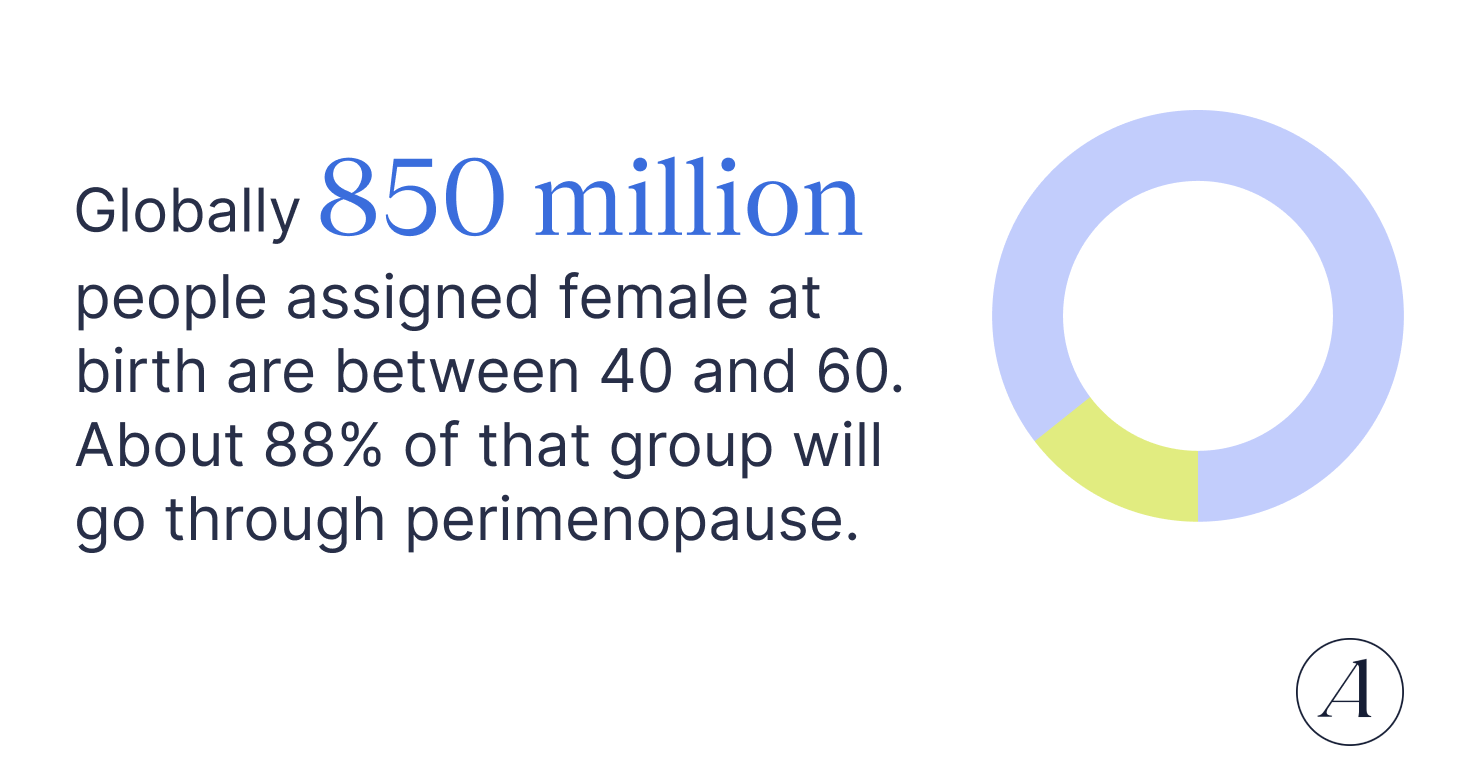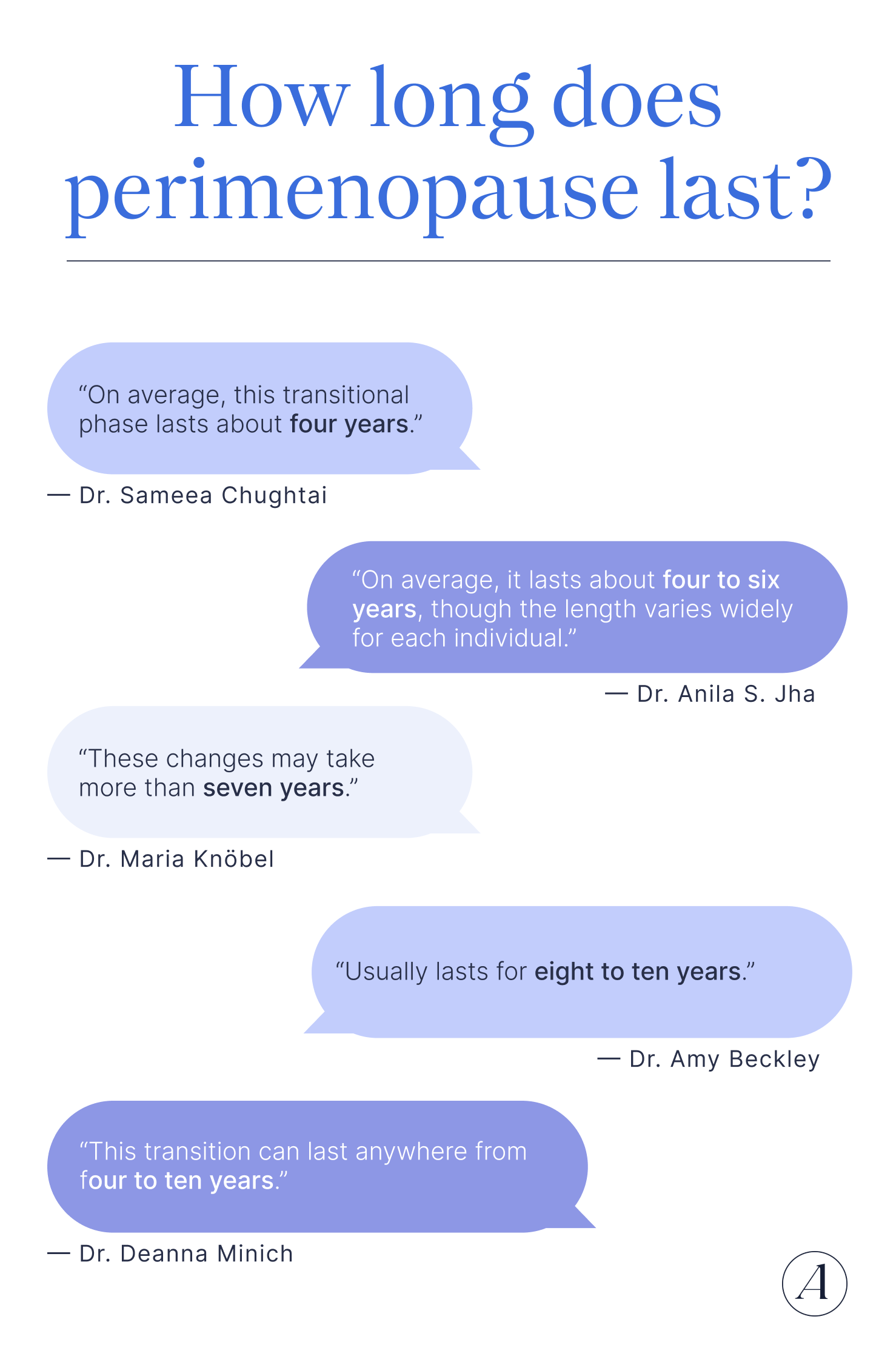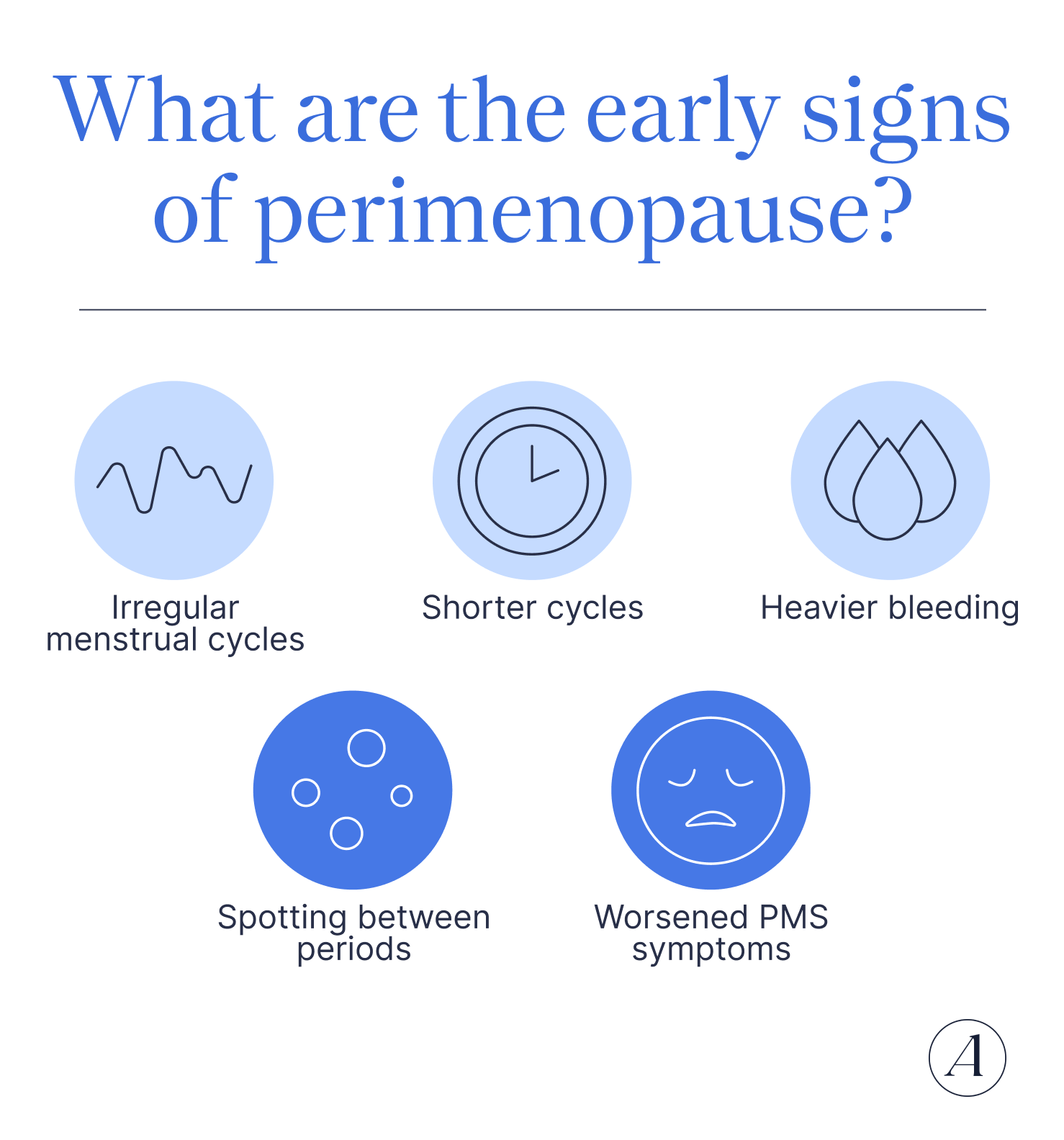
Perimenopause Timeline: How Early Can It Start and What To Expect
The transition into menopause, a phase called perimenopause, is different for everyone, and the exact beginning can be difficult to pinpoint. On average, it starts when you’re in your 40s, though it can begin in your 30s. You can look for symptom clues and ask your provider for guidance on whether you’re at this life stage.
Perimenopause can creep up on you like a stealthy cat, padding through the grass and stalking its prey until it pounces. You don’t really know it’s there in the background until suddenly your symptoms become more pronounced.
At first, perimenopause can bring on subtle symptoms, which can be different for everyone. For example, my early signs were tender breasts, slightly dryer skin, and an uptick in migraine attacks in my early 40s.
Then the hot flashes began a few years later. And that’s when I knew: I’d boarded the train to Menopause Town. That’s how I like to think of perimenopause. You’re on a slow-moving ride of changing hormones, moving in the direction of your final menstrual period. If you’re singing the lyrics “C’mon N’ Ride It (The Train) by Quad City DJ’s, circa 1996,” you’re not alone, and if you know the lyrics, it’s a good sign you’re at that perimenopausal age.

Globally, 850 million people assigned female at birth are between 40 and 60. About 88% of that group will go through perimenopause. (You might not go through a transitional period at all if you experience immediate menopause from surgery or medication. More on this below.)
You might be wondering what the average age of perimenopause is. The answer is complicated since different studies show different timelines, but the consensus is that most begin perimenopause by 45 to 47, The average age of menopause is 52, in the United States. So people can generally expect to start perimenopause about four to seven years prior to that.
You’ve hit menopause when you’ve shelved the tampons, pads, or cups for a full year. But this milestone is not evident for people, like me, who still have one or both ovaries but not a uterus. (RIP!)
In this article, we explore perimenopause age, perimenopause symptoms, stages of perimenopause, the perimenopause timeline, and more.
What is perimenopause?
All the “ause” terms can get a bit confusing. So let’s give them a whirl before we dig in to the nitty-gritty.
- Premenopause: You are technically premenopausal from your first period onward when you’re in your reproductive years.
- Perimenopause: You enter perimenopause, also called the menopause transition, when you undergo biological and hormonal shifts (including menstrual cycle changes) that put you on the path to menopause. You remain in perimenopause until one year after your final menstrual period.
- Menopause: Menopause is a moment in time when you’ve had an absence of a period for a full year.
- Postmenopause: You’re in post-menopause right away after you reach menopause and for the rest of your life.
- Premature menopause: Premature menopause is when someone naturally (but not medically) reaches early menopause, also called primary ovarian insufficiency (POI), before age 40.
- Medical menopause: Medical menopause occurs for people who go into immediate menopause from bilateral oophorectomy (surgical removal of both ovaries) or who take certain medications that suppress ovarian function; these include forms of chemotherapy, radiation, or hormonal suppressants.
When does perimenopause start?
It’s complicated. Why? The menopause transition varies for everyone, the onset is hard to pinpoint (since initial symptoms can be subtle or vague), research on the menopause trajectory is still somewhat limited, and lab testing is not always a reliable indicator; you need ongoing investigation and interpretation from a knowledgeable provider. Even scientists admit perimenopause is “ill-defined.”
Complicating matters is that some conditions can mimic early perimenopause symptoms. Polycystic ovary syndrome (PCOS) is a good example, since it can cause irregular cycles or an absence of them altogether.
The research consensus is that, on average, most people will have begun perimenopause by ages 45 to 47. However, some people may experience an earlier perimenopause trajectory, starting in their 30s.
To illustrate the complexity, I’m dropping in a few quotes from experts I interviewed on the topic.
- “Perimenopause usually begins sometime between the ages of 40 and 45,” says Deanna Minich, PhD, the chief science officer at Symphony Natural Health, “though it can start earlier depending on a woman’s genetics, diet, lifestyle, and overall endocrine health.”
- “The typical age for the start of perimenopause is usually 40,” says Amy Beckley, PhD, a scientist at Proov. “However, we are seeing women start perimenopause as early as 38 or as late as 48.”
- “Most guides say 40 is a starting point,” says Maria Knöbel, MMBS, the medical director of MedicalCert UK. “But I have patients as young as 36 with consistent cycle shifts, sleep disruption, and reactivity to stress. Some of them continue to bleed monthly and are told that everything is normal, but they do not feel like themselves anymore. The transformation is gradual yet consistent.”
- “Perimenopause typically begins in a woman’s mid-40s,” says Anila S. Jha, MD, of New England OB-GYN Associates. “But it can start anytime between the late 30s and early 50s.”
- “On average, this transitional phase lasts about four years and typically begins around age 47,” says Sameea Chughtai, MD, who specializes in the aging process and female health at Shah Facial Plastics.
All right, you get the idea. The only thing experts can agree on is that it starts at some point in midlife (say in your 40s), though it can happen earlier (say in your 30s).
Risk factors for early menopause include:
- A genetic predisposition
- Autoimmune diseases (e.g., thyroid disease and rheumatoid arthritis)
- Medications or treatments that damage or suppress the ovaries (e.g., chemotherapy, radiation, and targeted medications such as CDK and PARP inhibitors or anti-angiogenesis drugs)
- Smoking
- Low socioeconomic status and education (more on this below)
- Geographical region (more common in African, Latin American, Asian, and Middle Eastern countries)
- Childhood trauma
- Having shorter-than-average (<28 days) menstrual cycles
- Early menarche (your first period)
- Obesity
- Depression
- Being lefthanded
I am intrigued by the vast number of factors linked to early onset perimenopause, including which hand I use scissors with, so I want to elaborate on a few here. Let’s start with handedness. Being left-handed may correlate to autoimmune and reproductive disorders.. Researchers suspect these factors may contribute to a predisposition to early onset perimenopause, but more research is needed to investigate this association.
Scientists aren’t sure why the correlation exists between early perimenopause and lower socioeconomic status and lower education level. They’ve made the connection by examining existing scientific literature, but they call for more research exploring the connections.
Having shorter menstrual cycles, early menarche, or may deplete our egg stash a bit faster. We only have so many eggs in our ovaries, present at our birth, and the number declines as we age, so these factors may contribute to a more rapid depletion.
The experience of childhood trauma has been linked to worsened menopause symptoms, likely because of alterations in the stress response. Researchers need to explore this connection further, but it may play a role in undergoing early perimenopause or the symptoms (and severity) you encounter.
How long does perimenopause last?

Now that you have a loose idea of when perimenopause might begin, you might be wondering how long it lasts. That’s an equally complicated question to answer, as different studies and different medical experts will give you varying timelines.
The latest research suggests it lasts an average of four to seven years, but it can last up to 14 years. However, expert perspectives vary widely.
Here’s what our experts have to say:
- “On average, this transitional phase lasts about four years,” says Dr. Chughtai.
- “On average, it lasts about four to six years, though the length varies widely for each individual,” says Dr. Jha.
- “These changes may take more than seven years,” says Dr. Knöbel.
- “Usually lasts for eight to 10 years,” says Dr. Beckley.
- “This transition can last anywhere from four to 10 years,” says Dr. Minich.
What are the early signs of perimenopause?

The earliest signs of perimenopause can be subtle, and you may not even attribute them to perimenopause until they become more pronounced. What’s happening is that your ovaries are winding down their functioning, meaning eventually you will no longer ovulate (release an egg).
During this time, hormonal changes can cause your menstrual cycle, if you still have a uterus, to become a bit wonky.
You might notice:
- Irregular menstrual cycles
- Shorter cycles
- Heavier bleeding
- Spotting between periods
- Worsened premenstrual syndrome (PMS) symptoms
- And more
You have two main phases of your menstrual cycle, with ovulation serving as a transition between the two.
- Follicular phase: marked by the start of your period and lasting into ovulation
- Luteal phase: starts during ovulation and lasts until you get your period
During the early part of perimenopause, people tend to experience lower luteal phase progesterone and higher follicle-stimulating hormone (FSH). These changes may contribute to more rapid cycling that can trigger unexpected periods, skipped periods, heavier periods, and more.
But you may also experience other perimenopause symptoms. The list of potential symptoms is long, but some of the classics include:
- vasomotor symptoms (aka hot flashes and night sweats)
- sleep changes
- vaginal dryness
- mood changes
Knowing the stages of perimenopause and some of their classic correlating symptoms can help.
What are the stages of perimenopause and their symptoms?
The Stages of Reproductive Aging Workshop (STRAW) is a classification system for categorizing the reproductive trajectory for the female body, including the menopause transition and beyond. Here’s the breakdown of the seven stages and their sub stages for a total of 10.
Reproductive years
- Stage -5: You’ve experienced menarche (your first period) and have entered your early reproductive years.
- Stage -4: You’re in your peak reproductive years.
- Stages -3b and -3a: You’re in your late reproductive years and getting close to perimenopause. Though you may notice some cycle irregularity here, especially in -3a, where shorter, more rapid cycles are common.
Perimenopause
- Stage -2: You’re in early perimenopause, which could last for several years. Progesterone is declining, and estrogen is erratic. You will likely begin experiencing early symptoms of perimenopause, such as irregular menstrual cycles. Researchers define this as having a seven-day-or-greater difference from your usual cycle length, such as a shift from a 28-day cycle to a 21-day cycle.
- Stage -1: You’re in late perimenopause, which often lasts for one to three years. A good indicator is having the absence of a period for 60 days or more. This is usually when vasomotor symptoms begin. Estrogen levels can still be highly erratic and FSH may increase.
- Stage +1a: You’ve reached your final menstrual period. You are still in perimenopause until you’ve had an absence of a period for 12 consecutive months. Vasomotor symptoms are highly likely. FSH increases and estrogen levels dramatically decline.
Postmenopause
- Stage +1b: You’ve entered postmenopause. You’ve had an absence of a period for a full year and have reached that moment in time that is menopause. In the United States, the average age of menopause is 52. For the next year, you’ll be in this entry phase.
- Stage +1c: You’re in early postmenopause for the next three to six years. Your hormone levels begin to stabilize at their new levels during this time.
- Stage +2: You’re in late postmenopause for the remainder of your life. Likely you are experiencing pronounced urogenital atrophy, the drying and thinning of vaginal and urethral tissue.
What are the best ways to manage perimenopause symptoms?
Menopause symptoms can be divided into two main categories, physical and psychological, since mood can fluctuate with the hormonal changes, as well. Management will depend on your unique set of symptoms, but here are a few options to consider.
Hormone replacement therapy
Hormone replacement therapy (HRT), often now more appropriately called hormone therapy (HT), is a first line of treatment in perimenopause care. This involves taking hormones, either synthetic (manufactured in a lab) or bioidentical (chemically the same as your own). Options include pills, creams, patches, etc. If you still have a uterus, you will need progesterone therapy if you are taking estrogen therapy to prevent endometrial hyperplasia (thickening of the lining of the uterus). If you no longer have a uterus, you can be prescribed estrogen-only HT.
Not everyone is a candidate for HT or all forms, including myself because of a hypersensitivity to progesterone and a history of deep vein thrombosis (a blood clot), among other factors. Another friend can’t take it because of a previous hormone-receptor-positive cancer. So talk to your provider about your specific circumstances. As a note, my doctor really went to work for me to figure out what was possible. If he hadn’t, I would have sought out a provider who was willing to explore all my options.
Medications
Some medications can also help with the menopause transition. For mood concerns, antidepressants may help; as a bonus some of these also help with hot flashes and sleep concerns. The medication fezolinetant (sold under the brand name Veozah) can also help with hot flashes. The Food and Drug Administration (FDA) has approved Vehozah for use in people who have reached menopause. However, your provider might prescribe it off-label if you are experiencing hot flashes during perimenopause.
Supplements
Some supplements may be beneficial for perimenopause symptoms. Here’s what the experts recommend.
- “To soften the transition, 300 milligrams of magnesium glycinate is useful,” David Ghozland, MD, says.
- “Supplements like calcium and vitamin D support bone health,” says Dr. Jha.
- “Ashwagandha is a popular adaptogenic herb known for its calming effects and support in reducing stress and mood swings,” says Dr. Chughtai.
- “Black cohosh has also been widely used to ease hot flashes and night sweats, though it’s important to note that it should be avoided by women with a history of breast cancer,” Dr. Chughtai adds.
- In early perimenopause, Dr. Beckley recommends vitex and maca.
Lifestyle changes
Lifestyle changes can also help with perimenopause, and you likely won’t be surprised to see that they are healthy habits for any stage of life.
Prioritize sleep
Sleep is crucial for supporting and regulating your hormones and overall well-being. Aim for at least seven hours of sleep per night and reduce potential disruptions where possible, such as light or noise pollution.
Of course, I recognize the madness of suggesting you get more sleep when poor sleep is a symptom of perimenopause. So what can you do? If you are having sleep difficulties, talk to your provider about solutions.
Manage stress
Stress can hit a little differently in perimenopause when you’re also potentially experiencing mood changes. But doing what you can to mitigate stress can improve your well-being in perimenopause.
Eat a healthy diet
“Staying hydrated and focusing on a balanced diet rich in whole foods, lean proteins, and healthy fats can also support overall well-being,” says Dr. Chughtai.
Get regular exercise
Strength training can be particularly beneficial for regulating blood sugar levels. This is important since the postmenopausal life stage can put people more at risk for prediabetes and type 2 diabetes.
Building muscle can also help mitigate some of the frustrating body composition changes that can occur in perimenopause, such as fat gain, especially around the abdomen, and muscle and bone loss.
Key takeaway
- Perimenopause typically begins in one’s 40s, though it can start in your 30s.
- The perimenopause trajectory is different for everyone, but some classic symptoms, such as a changing menstrual cycle, can offer early clues that you’ve started the transition.
- HRT, other medications, and lifestyle change can help you manage perimenopause, which can last for a decade or more.
- If you’re experiencing symptoms of the menopause transition, Allara can help build a personalized treatment plan to ease your symptoms and boost overall health.
FAQ
How do I know if I’m starting perimenopause?
To know if you’re starting perimenopause, you can look for some common clues. Perimenopause typically begins when you’re in your 40s, though it can occur in your 30s. Some early signs include menstrual cycle irregularities, including more frequent periods. You might also notice mood changes or additional symptoms, such as sleep disturbances, hot flashes, or night sweats, for which you can rule out additional causes.
What is the average age for perimenopause?
The research consensus is that, on average, most people will have begun perimenopause by ages 45 to 47. However, some people may experience an earlier perimenopause trajectory, starting in their 30s.
How long does perimenopause last?
The latest research suggests it lasts an average of four to seven years, but it can last up to 14 years.
Can you start perimenopause in your 30s?
Yes, although perimenopause, on average, occurs during one’s 40s, it can start in your 30s. Some factors, such as smoking or starting your period at a younger-than-average age, may contribute to starting perimenopause earlier.













